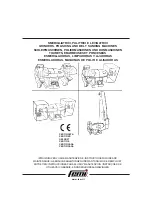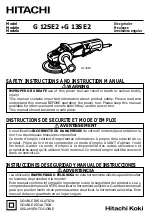
DANGER
In certain conditions during fueling, static
electricity can be released, causing a spark
that can ignite the fuel vapors. A fire or
explosion from fuel can burn you and others
and can damage property.
•
Always place fuel containers on the ground
away from your vehicle before filling.
•
Do not fill fuel containers inside a vehicle
or on a truck or trailer bed, because interior
carpets or plastic truck bed liners may
insulate the container and slow the loss of
any static charge.
•
When practical, remove equipment from
the truck or trailer and refuel the equipment
with its wheels on the ground.
•
If this is not possible, then refuel such
equipment on a truck or trailer from a
portable container rather than from a
fuel-dispenser nozzle.
•
If you must use a fuel-dispenser nozzle,
keep the nozzle in contact with the rim of
the fuel tank or container opening at all
times until fueling is complete.
WARNING
Fuel is harmful or fatal if swallowed.
Long-term exposure to vapors can cause
serious injury and illness.
•
Avoid prolonged breathing of vapors.
•
Keep your face away from the nozzle and
fuel tank opening.
•
Keep fuel away from your eyes and skin.
Recommended Fuel
•
For best results, use only clean, fresh (less than
30 days old), unleaded gasoline with an octane
rating of 87 or higher ((R+M)/2 rating method).
•
Ethanol
: Gasoline with up to 10% ethanol
(gasohol) or 15% MTBE (methyl tertiary butyl
ether) by volume is acceptable. Ethanol and
MTBE are not the same. Gasoline with 15%
ethanol (E15) by volume is not approved for use.
Never use gasoline that contains more than
10% ethanol by volume
, such as E15 (contains
15% ethanol), E20 (contains 20% ethanol), or E85
(contains up to 85% ethanol). Using unapproved
gasoline may cause performance problems and/or
engine damage which may not be covered under
warranty.
•
Do not
use gasoline containing methanol.
•
Do not
store fuel either in the fuel tank or fuel
containers over the winter unless you use a fuel
stabilizer.
•
Do not
add oil to gasoline.
Using Stabilizer/Conditioner
Use fuel stabilizer/conditioner in the machine at all
times to keep the fuel fresh longer when used as
directed by the fuel-stabilizer manufacturer.
Important:
Do not use fuel additives containing
methanol or ethanol.
Add the amount of fuel stabilizer/conditioner to fresh
fuel as directed by the fuel-stabilizer manufacturer.
Filling the Fuel Tank
1.
Park the machine on a level surface and engage
the parking brake.
2.
Shut off the engine and allow the engine to cool.
3.
Clean around the fuel-tank cap and remove it
(
).
g014513
Figure 7
1.
Fuel-tank cap
4.
Fill the tank with fuel to about 6 to 13 mm (1/4 to
1/2 inch) below the bottom of the filler neck.
Important:
This space in the tank allows
fuel to expand. Do not fill the fuel tank
completely full.
5.
Install the fuel-tank cap securely.
6.
Wipe up any spilled fuel.
9










































